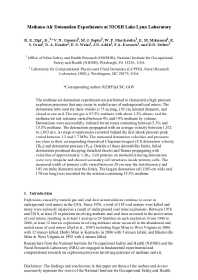Mining Publication: Methane-Air Detonation Experiments at NIOSH Lake Lynn Laboratory
Original creation date: September 2010
The methane-air detonation experiments are performed to characterize high pressure explosion processes that may occur in sealed areas of underground coal mines. The detonation tube used for these studies is 73 m long, 105 cm internal diameter, and closed at one end. The test gas is 97.5% methane with about 1.5% ethane, and the methane-air test mixtures varied between 4% and 19% methane by volume. Detonations were successfully initiated for mixtures containing between 5.3% and 15.5% methane. The detonations propagated with an average velocity between 1,512 to 1,863 m/s. Average overpressures recorded behind the first shock pressure peak varied between 1.2 and 1.7 MPa. The measured detonation velocities and pressures are close to their corresponding theoretical Chapman-Jouguet (CJ) detonation velocity (DCJ) and detonation pressure (PCJ). Outside of these detonability limits, failed detonations produced decaying detached shocks and flames propagating with velocities of approximately 1/2 DCJ. Cell patterns on smokefoils during detonations were very irregular and showed secondary cell structures inside primary cells. The measured width of primary cells varied between 20 cm near the stoichiometry and 105 cm (tube diameter) near the limits. The largest detonation cell (105-cm wide and 170-cm long) was recorded for the mixture containing 15.3% methane.
Authors: RK Zipf, VN Gamezo, MJ Sapko, WP Marchewka, KM Mohamed, ES Oran, DA Kessler, ES Weiss, JD Addis, FA Karnack, DD Sellers
Conference Paper - September 2010
NIOSHTIC2 Number: 20037639
Proceedings of the Eighth International Symposium on Hazards, Prevention, and Mitigation of Industrial Explosions, September 5-10, 2010, Yokohama, Japan. Japan: Keio University, ISH110, 2010; :1-11
See Also
- Detonation Wave Propagation in Underground Mine Entries
- Direct Method Determination of the Gas Content of Coal: Procedures and Results
- Explosion Pressure Design Criteria for New Seals in U.S. Coal Mines
- Explosion Prevention in United States Coal Mines
- Historical Development of Technologies for Controlling Methane in Underground Coal Mines
- Measuring Formation Pressures and the Degree of Gas Drainage in a Large Coalbed Gas Drainage Field
- Methane Diffusion Parameters for Sized Coal Particles: A Measuring Apparatus and Some Preliminary Results
- NIOSH Research in Coal Dust and Explosions
- Relationship Between Radiated Seismic Energy and Explosive Pressure for Controlled Methane and Coal Dust Explosions in an Underground Mine
- Seal Design
- Technology News 490 - An Inexpensive Device for Monitoring Explosions in Sealed Areas of Underground Mines
- Page last reviewed: 9/21/2012
- Page last updated: 9/21/2012
- Content source: National Institute for Occupational Safety and Health, Mining Program


 ShareCompartir
ShareCompartir
